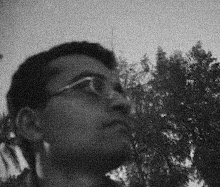
64 year old gentleman was diagnosed to have lacrimal gland adenoid cystic carcinoma following excision of a mass under the right eyebrow, via lateral orbitotomy, done in a hospital elsewhere in March 2004. Following that he presented in ophthalmology OPD with a firm lobulated mass in right eye below eyebrow. A biopsy was done, which confirmed the diagnosis. He completed radiotherapy in 23/12/08 since further surgery was deemed not possible at that time.
[40 cGy in 20 fractions, field size 15X6 cms to right eye, tumor depth 4 cms, 24 cGy in 12 fractions, right anterior and right lateral fields with wedges and left eye shielded].
In 24/1/07, the tumor recurred. [FNAC 572/07] and in 24/06/07 he underwent local re-excision of the mass.
In 28/1/08 he presented with pain and bleeding from right eye and was evaluated with a CT scan which showed tumor recurrence. He had undergone cataract excision and intraocular lens placement in left eye in 12/2/08. On examination he had a firm mass felt under the lateral aspect of right eyebrow, with surrounding edema causing ptosis and chemosis in right eye. There was no useful vision in right eye.
Ct scan had revealed an enhancing lesion in the right orbit lateral to the globe which was eroding the roof and lateral wall of the orbit. Metastatic work up was negative.
On 23/2/08 he underwent exenteration of the right orbit[ophthal], followed by excision of the roof and lateral walls of the orbit after a right fronto-temporal craniotomy [neurosurgery. The firm tumor, the involved orbital ridge and a margin of bone up to the orbital apex were excised. A few areas of inadvertent dural tears were repaired using pericranial patch. Frontal sinus was exteriorized. Temporalis muscle was placed in the socket and a local rotation flap was used to cover the bare socket. [plastic] Post operatively he had a few episodes of CSF rhinorrhea which settled with lumbar drainage.
Post op CT scan had showed complete excision of the tumor and bone excision up to the orbital apex.
After one and half months of discharge from hospital he presented with purulent discharge from right nostril with tenderness in right maxillary sinus area. This was treated with sinus washes and antibiotics. He complained of occasional episodes of clear watery discharge from right nostril suggestive of CSF rhinorrhea. This tended to occur in right lateral position as he gets up from sleep.
He was re-admitted for evaluation and treatment of possible CSF rhinorrhea. An MRI with Ciss 3d sequence could not reliably pick up a site of leak. So he underwent lumbar puncture and intra-thecal contrast cisterography in prone position to identify site of leak. This investigation also failed to reveal a leak. He was on lumbar csf drainage for five days prior to contrast cisternography . The CSF sample which was taken on the last day prior to removing the catheter had plenty of pus cells and grew acinetobacter sensitive to meropenam, amikacin , ceftazidime and ciprofloxacin. He also had headache and mild meningeal signs. Meningeal signs and fever settled with meropneam [given initially for three days] and other sensitive antibiotics. Csf leak also disappeared.
At discharge he is afebrile, ambulant and comfortable.
Discussion:
Patient had recurrence of lesion after initial surgery, radiation therapy and re-excision. An oncologically adequate resection required excision of the tumor and in addition, the involved orbital bone with adequate margins. This necessitated a fronto-temporal craniotomy followed by excision of the roof and lateral walls of the orbit up to the orbital apex after exenteration of the eye. This should maximize the chances of complete tumor excision and minimize risk of further recurrence of this type of highly malignant tumor.
Symptoms suggestive of delayed leak were reported by the patient. However the site of the leak could not be ascertained by either a ciss 3d sequence of mri or by contrast cisternogram. Hence a direct repair could not be carried out. Also the leak never occurred during hospital stay after initiation of csf drainage. It is possible that the leak is not detected since it is intermittent. Patient developed meningeal signs after removal of the csf catheter [iatrogenic or as a result of unapparent csf rhiorrhea]. This resolved within a day of starting antibiotics. Also the leak seems to have spontaneously resolved. If leak recurs in future, a lumboperitoneal shunt procedure may be carried out as site of leak is obscure to do an anatomical repair. Intradural exploration, re-exterioirization of frontal sinus, anterior fossa carpeting with a large pericranial or fascia lata graft can also be considered as an alternative.
He requires careful and regular imaging follow up to rule out tumor recurrence.





0 comments:
Post a Comment